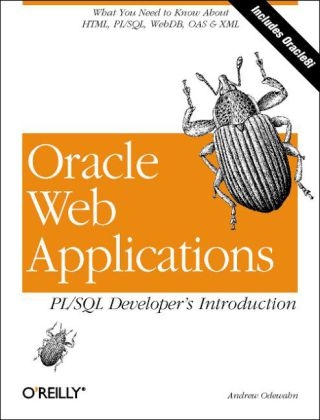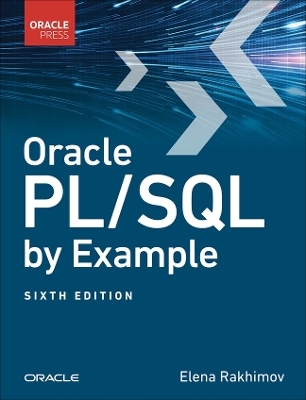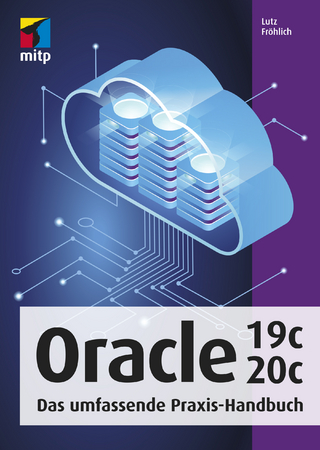
Oracle Web Applications
O'Reilly Media (Verlag)
978-1-56592-687-5 (ISBN)
- Titel ist leider vergriffen;
keine Neuauflage - Artikel merken
This compact guide provides the jump-start Oracle developers need to make the transition from traditional programming to the development of useful Web applications for Oracle8i. Even readers who start out knowing nothing about HTML, PL/SQL, or Oracle's other tools will learn how to create simple Web applications in a matter of days. The book focuses on Oracle8i, but also covers Web development for earlier Oracle versions (Oracle8 and Oracle7). Background: The explosion in the use of the Internet and the Web has resulted in a whole new way of doing business. Developers who only yesterday were using COBOL to write accounts payable systems are now being asked to create a broad range of new Internet-based applications ranging from electronic commerce (e-commerce) Web sites to internal data warehouses to enterprise resource planning (ERP) systems. Unfortunately, the filesystem architectures of most Web systems aren't up to the task. The new breed of Web applications -- which are quickly becoming critical resources that companies need to survive -- demand a platform that provides production-quality tools for content management, application development, and application integration.
And current Web techniques are inadequate in many ways. Oracle8i, Oracle's "Internet database," gives Web developers a way to build Web technology on top of a relational database, rather than on a traditional filesystem. With Oracle8i, companies can apply well understood, reliable, production-quality database methodologies to Web content management. Oracle8i also supports a wide variety of application development platforms and tools that are tightly integrated to the core database. Finally, Oracle8i supports technologies that help companies tie their Web-based applications into legacy applications. There is a lot to learn in Oracle8i. Not only does it enhance basic database features, it introduces Java and a variety of Web development tools. Oracle8i provides a soup-to-nuts platform for Web site and Web application development that extends traditional database concepts to Web content. It replaces the traditional filesystem used by most Web servers with a database management system. Many users are intimidated by the vast array of new technologies in Oracle8i. And yet, they are under pressure to use these technologies to build complex Web applications right now.
This book gives such users a way to start using Oracle8i immediately to create useful Web applications. It is a concise, easy-to-read guide to the basic technologies developers need to understand in order to build Web applications. Contains: The book describes the following Web development tools: PL/SQL-- a structured programming language that combines procedural constructs and standard SQL. It offers such features as cursors, loops, conditional and sequential control statements, exception handlers, records, tables, and constructs for developing modular code (functions, procedures, and packages). PL/SQL Toolkit -- a set of PL/SQL packages supplied by Oracle for use in developing Web applications. HTML -- an ASCII-based markup language used to create Web pages. WebDB -- A software system for building, monitoring, and creating content-driven Web sites; it allows users to use a Web browser to access and store information in the Oracle8i database. Oracle Application Server (OAS) -- an extensible Web server that uses plug-in programs called cartridges to allow database-integrated Web systems to be developed in a variety of languages (e.g., PL/SQL, Java, Perl).
XML -- An emerging standard for creating self-describing documents. It is similar to HTML but allows you to create your own markup tags. XML is expected to be a key technology in electronic commerce systems. The book also presents several fully realized sample Web applications that will teach you how to build such applications of your own. NOTE: Although this book touches on the Java features of Oracle8i, it doesn't cover Java development per se. Switching to Java represents an enormous change for most Oracle developers. This book provides an evolutionary path for readers who want to do useful Oracle8i Web development now, using mostly familiar tools. Additional books will provide Java training for those who have mastered these Web tools and want to take the next step.
Andrew Odewahn is an Oracle application developer and consultant who lives in Davis Square in Somerville, Massachusetts. He has a degree in computer science from the University of Alabama, where he was a fellow in the Computer-Based Honors Program. He has presented at the East Coast Oracle Developers (ECO) Conference and other Oracle events. He and his wife both love the outdoors and, as this book goes to press in the summer of 1999, are hiking the Appalachian Trail from Georgia to Maine.
Preface. 1. Introduction The Internet Grows Up Current Web Techniques Are Inadequate Oracle's Solution - Oracle8i A Roadmap to Oracle8i. 2. Foundations Resources Server-to-Client Communication Content Delivery Model Database Integration Database Security Review. 3. WebDB Overview of WebDB WebDB Architecture. 4. Oracle Application Server (OAS) How OAS Returns Web Resources Creating Dynamic Resources. 5. HTML Programming in HTML A Whirlwind Tour. 6. PL/SQL Structured Programming in PL/SQL Programming Constructs Packages PL/SQL Tools. 7. The PL/SQL Toolkit Communicating with the Outside World Text Processing Maintaining State Improving Productivity. 8. Developing Applications Designing a Web Application Example 1: An Anonymous Survey Example 2: A Discussion Forum. 9. XML Motivations for XML XML Syntax The Document Type Definition (DTD) The XML Parser Example: Generating an XML Invoice from Oracle PLSXML Utilities and Demos XML and i FS Appendix: Resources for the Oracle Web Developer
| Erscheint lt. Verlag | 15.11.1999 |
|---|---|
| Zusatzinfo | illustrations |
| Verlagsort | Sebastopol |
| Sprache | englisch |
| Maße | 178 x 232 mm |
| Gewicht | 520 g |
| Einbandart | kartoniert |
| Themenwelt | Informatik ► Datenbanken ► Oracle |
| Mathematik / Informatik ► Informatik ► Netzwerke | |
| Mathematik / Informatik ► Informatik ► Software Entwicklung | |
| Mathematik / Informatik ► Informatik ► Web / Internet | |
| ISBN-10 | 1-56592-687-0 / 1565926870 |
| ISBN-13 | 978-1-56592-687-5 / 9781565926875 |
| Zustand | Neuware |
| Haben Sie eine Frage zum Produkt? |
aus dem Bereich


